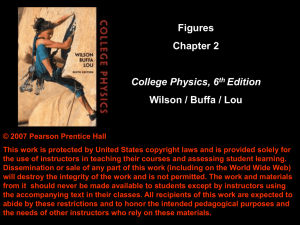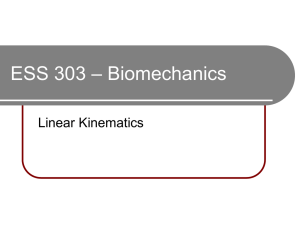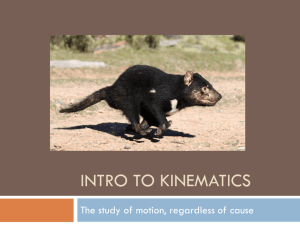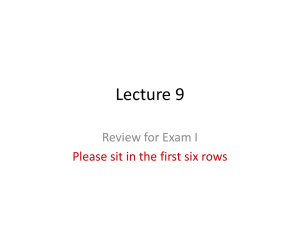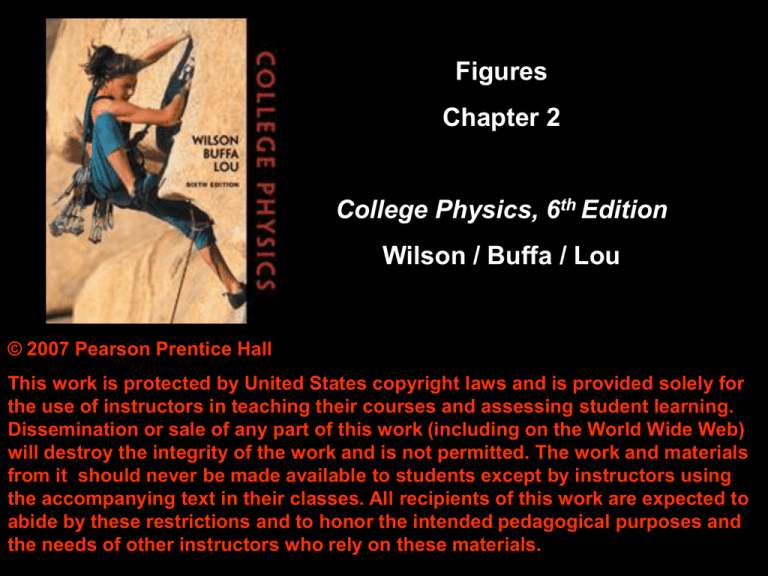
Figures
Chapter 2
College Physics, 6th Edition
Wilson / Buffa / Lou
© 2007 Pearson Prentice Hall
This work is protected by United States copyright laws and is provided solely for
the use of instructors in teaching their courses and assessing student learning.
Dissemination or sale of any part of this work (including on the World Wide Web)
will destroy the integrity of the work and is not permitted. The work and materials
from it should never be made available to students except by instructors using
the accompanying text in their classes. All recipients of this work are expected to
abide by these restrictions and to honor the intended pedagogical purposes and
the needs of other instructors who rely on these materials.
Figure 2-1
Distance – total path length
In driving to State University from
Hometown, one student may take
the shortest route and travel a
distance of 81 km (50 mi). Another
student takes a longer route in
order to visit a friend in Podunk
before returning to school. The
longer trip is in two segments, but
the distance traveled is the total
length, 97 km + 48 km = 145 km
(90 mi).
Figure 2-4 Distance (scalar) and displacement (vector)
(a) The distance (straight-line path) between the student and the physics lab is 8.0 m
and is a scalar quantity.
(b) To indicate displacement, x1 and x2 specify the initial and final positions,
respectively. The displacement is then Δx = x2 – x1 = 9.0 m – 1.0 m = +8.0 m — that
is, 8.0 m in the positive x-direction.
Learn by Drawing 2-1
Cartesian Coordinates and OneDimensional Displacement
(a) A two-dimensional Cartesian coordinate
system. A displacement vector d locates
a point (x, y).
(b) For one-dimensional, or straight-line,
motion, it is convenient to orient one of
the coordinate axes along the direction of
motion.
Figure 2-6
Uniform linear motion –
constant velocity
In uniform linear motion, an object travels at
a constant velocity, covering the same
distance in equal time intervals. (a) Here, a
car travels 50 km each hour.
(b) An x-versus-t plot is a straight line, since
equal displacements are covered in equal
times. The numerical value of the slope of
the line is equal to the magnitude of the
velocity, and the sign of the slope gives its
direction. (The average velocity equals the
instantaneous velocity in this case. Why?)
Figure 2-7
Position-versus-time graph for an object in uniform motion in the
negative x-direction
A straight line on an x-versus-t plot with a negative slope indicates uniform motion
in the negative x-direction. Note that the object’s location changes at a constant
rate. At t = 4.0 h the object is at x = 0. How would the graph look if the motion
continues for t > 4.0 h?
Figure 2-8
Position-versus-time graph for an object in nonuniform linear motion
For a non-uniform velocity, an xversus-t plot is a curved line. The
slope of the line between two points
is the average velocity between
those positions, and the
instantaneous velocity is the slope
of a line tangent to the curve at any
point. Five tangent lines are shown,
with the intervals for Δx/Δt in the
fifth. Can you describe the object’s
motion in words?
Figure 2-9
Acceleration – the time rate of change of velocity
Since velocity is a vector quantity, with magnitude and direction, an acceleration can
occur when there is (a) a change in magnitude, but not direction; (b) a change in
direction, but not magnitude; or (c) a change in both magnitude and direction.
Learn by Drawing 2-2
Signs of Velocity and
Acceleration
Figure 2-10
Velocity-versus-time graphs for motions with constant
accelerations
Ex. 2.7 Two riders on dune buggies sit 10 m apart on a long straight track, facing in
opposite directions. Starting at the same time, both riders accelerate at a costant rate
of 2.0 m/s2. How far apart will the dune buggies be at the end of 3.0s?
Figure 2-11 Away they go!
Example 2.8 The stopping distance of a vehicle is an important factor in road safety.
This distance depends on the initial velocity (vo) and the braking capacity which
produces the deceleration, a., assumed to be constant. Express the stopping distance
x in terms of these quantities.
Figure 2-12 Vehicle stopping distance
Figure 2-13
v-versus-t graphs, one more time
(a) In the straight-line plot for a
constant acceleration, the area
under the curve is equal to x, the
distance covered.
(b) If v0 is not zero, the distance is still
given by the area under the curve,
here divided into two parts, areas
A1 and A2 .
Figure 2-14
Free fall and air resistance
(a) When dropped simultaneously
from the same height, a feather falls
more slowly than a coin, because of
air resistance. But when both objects
are dropped in an evacuated
container with a good partial vacuum,
where air resistance is negligible, the
feather and the coin both have the
same constant acceleration.
Figure 2-16
Free fall up and down
Ex. 2.11 A worker on a scaffold in front
of a billboard throws a ball straight up.
The ball has an initial speed of 11.2
m/s, when it leaves the worker’s hand.
(a) What is the maximum height the ball
reaches relative to the top of the
billboard? (b) How long does it take the
ball to reach this height? (c) What is the
position of the ball at t = 2.0 s?
Figure 2-19
Speed versus velocity
13. An insect crawls along the edge of a rectangular swimming pool of length 27 m and
width 21 m. If it crawls from corner A to corner B in 30 min, (a) what is its average speed
and (b) what is its average velocity?
Figure 2-20
Position versus time
14. A plot of position versus time is shown in Fig. 2.20 for an object in linear motion.
(a) What are the average velocities for the segments AB, BC, CD, DE, EF, FG, and
BG? (b) State whether the motion is uniform or nonuniform in each case. (c) What is
the instantaneous velocity at point D?
Figure 2-21
Position versus time
15. In demonstrating a dance step, a person moves in one dimension, as shown in
Fig. 2.21. What are (a) the average speed and (b) the average velocity for each phase
of the motion? (c) What are the instantaneous velocities at 2.5 s, 4.5 s, and 6.0 s? (d)
What is the average velocity for the interval between and [Hint: Recall that the overall
displacement is the displacement between the starting point and the ending point.]
Figure 2-22
When and where do they meet?
22. Two runners approaching each other on a straight track have constant speeds of
and respectively, when they are 100 m apart (Fig. 2.22). How long will it take for the
runners to meet, and at what position will they meet if they maintain these speeds?
Figure 2-21
Description of motion
Figure 2-23
Velocity versus time
33. What is the acceleration for each graph segment in Fig. 2.23? Describe the
motion of the object over the total time interval.
Figure 2-23
Velocity versus time
Figure 2-24
Hit the professor
Figure 2-25
From where did it come?
77. A car and a motorcycle start from rest at the same time on a straight track, but the
motorcycle is 25.0 m behind the car (Fig. 2.26). The car accelerates at a uniform
rate of and the motorcycle at a uniform rate of (a) How much time elapses before the
motorcycle overtakes the car? (b) How far will each have traveled during that time? (c)
How far ahead of the car will the motorcycle be 2.00 s later? (Both vehicles are still
accelerating.)
Figure 2-27. A tie race
Figure 2-28
Down she comes



